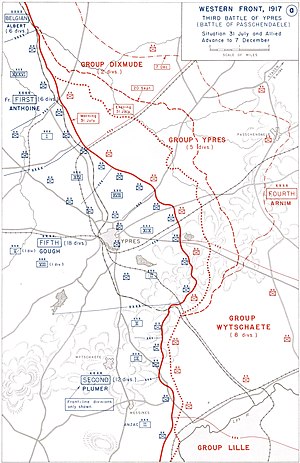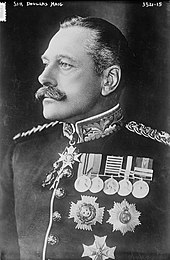Battle of Passchendaele
Third Battle of Flanders
Part of: World War I

Map of the battle with participating units
The Third Battle of Flanders in World War I was an attempt by the Allies on the Western Front to achieve a breakthrough in the Ypres area, hence the name Third Battle of Ypres. It began on 31 July 1917 and ended on 6 November 1917 with the capture of the village of Passendale (Passchendaele). The battle, one of the most outstanding material battles of the First World War, is counted among the four battles of Flanders.
The Allies' aim was to invade Belgium and liberate the ports on the Belgian coast occupied by the Germans - from here they attacked British ships. They wanted to break through the German defensive belt on the West Flanders ridge; for this, the village of Passchendaele had to be conquered first.
The Third Battle of Flanders was broken up into several battle designations by the attacking English because of its month-long duration. The introductory battle of 7 June was called the Battle of Messines and was intended to divert attention from the section of the main offensive that was launched on 31 July with the Battle of Pil(c)kem. From 16 August the fighting was concentrated at Langemarck, from 20 September at Menen, and from 26 September at the Battle of Polygon Wood. The later offensives are known as the Battle of Broodseinde (4 October), the Battle of Poelcapelle (9 October), the First Battle of Passchendaele (12 October), and from 26 October until the Battle of Flanders subsided, the Second Battle of Passchendaele.
The British failed to break through on the Western Front and neutralize the German submarine bases on the Belgian coast. The gains in terrain were nominally quite significant (about 50 square miles or 130 km²), but did not bring any significant strategic advantages and were bought with enormous losses of soldiers and war material. That is why the Flanders Offensive stands today for the brutality and futility of this war.
Initial Situation
The war year 1917 was marked by the collapse of the Russian Empire. After Romania had been largely occupied by the Central Powers at the end of 1916/beginning of 1917, calm had already essentially returned to the Eastern Front. The signs of disintegration in the Russian army were already obvious in the spring of 1917. The German Western Front had been significantly shortened by a retreat (Unternehmen Alberich) to the Siegfried position in March 1917 in order to save forces, which put the Western Allies under pressure.
The Allies launched several major offensives on the Western Front, which did not bring about any significant changes. The reasons for this were poor planning, underestimation of German fighting strength, poorly planned use of new weapons such as tanks and guns, and ultimately the exhaustion of materiel. In April, the British attempted a breakthrough in the Artois (Battle of Arras, 9 April to 16 May) and the French a week later on the Aisne and in the Champagne (16 April to the end of May). In this they used more troops and guns than at the Battle of Verdun. The result, however, was heavy losses, especially on the French side. Mutinies occurred, to which the French military leadership initially responded with draconian punishments (hundreds of death sentences). The French commander-in-chief on the Western Front and eponym of the offensive, General Robert Nivelle, had to vacate his post, which he had only taken over in December 1916, in May 1917. His successor, General PhilippePétain, confined himself largely to the defensive for the rest of 1917, bringing the mutinies under control by providing better rations and rest periods to spare the troops. A gradual improvement in morale occurred.
Germany declared unrestricted submarine warfare on February 1, 1917, putting pressure on the British Navy and merchant fleet. However, this also had the effect that the USA entered the war against Germany (on 6 April 1917), which the German army leadership greatly underestimated. However, greater effects of this entry into the war did not become apparent until the year of the war, 1918, where they were ultimately decisive in Germany's defeat. The USA, despite its official neutrality, was rather inclined towards the positions of the Entente; at that time many expected an entry into the war (sooner or later) in their favour. The U.S. president from 1913 to 1921 was the Democrat Woodrow Wilson. He had been re-elected in the November 1916 presidential election and had led his country into war after the increased submarine incidents and the Zimmermann Dispatch.
Planning
The British commander-in-chief Sir Douglas Haig planned an operation in the Flanders area as early as 1916. These plans were postponed because of the Battle of the Somme (1 July to 18 November 1916). With the Battle of Fromelles, only a diversionary attack for the Battle of the Somme in Flanders took place in July 1916. A Franco-British double offensive at Arras and on the Aisne was initially scheduled for the spring of 1917, but failed to achieve the desired success. Haig subsequently turned his attention back to Flanders - partly because the bulk of the French army was incapable of coordinated operations due to severe mutinies over a period of months. His long-cherished intention was to break through to the Belgian coast and capture the German submarine bases at Ostend and Zeebrugge, thus eliminating the danger posed by the German U-boats. It was also intended to shorten the front line and enable German troops to be encircled.
Haig believed, as he had with the Somme offensive, that the German army was on the verge of collapse. Prime Minister David Lloyd George was very critical of the offensive, but gave his blessing to the plans.
In order to guarantee a success of the main offensive, the German positions of the Wytschaete arc on the ridge of the Wijtschate and Mesen (Wytschaete and Messines) had to be captured first, otherwise no attack on the submarine bases was possible.

General Douglas Haig
Questions and Answers
Q: What was the Battle of Passchendaele?
A: The Battle of Passchendaele was one of the biggest battles of the First World War.
Q: When did the Battle of Passchendaele take place?
A: The Battle of Passchendaele took place between July and November 1917.
Q: Who were the Allied troops in the Battle of Passchendaele?
A: The Allied troops in the Battle of Passchendaele were commanded by British leaders.
Q: What was the purpose of the Battle of Passchendaele?
A: The purpose of the Battle of Passchendaele was to "wear out the enemy" and "to secure the Belgian coast and connect with the Dutch front lines".
Q: Who was the British commander in the Battle of Passchendaele?
A: The British commander in the Battle of Passchendaele was Douglas Haig.
Q: What were the three parts of the plan of the Battle of Passchendaele?
A: The three parts of the plan of the Battle of Passchendaele were capturing Passchendaele Ridge, moving to capture Roeselare, and Operation Hush.
Q: What was the aim of Operation Hush in the Battle of Passchendaele?
A: The aim of Operation Hush in the Battle of Passchendaele was for marines to land somewhere on the Belgian coast and there would be a breakout attack from Nieuwpoort and the Yser bridgehead.
Search within the encyclopedia